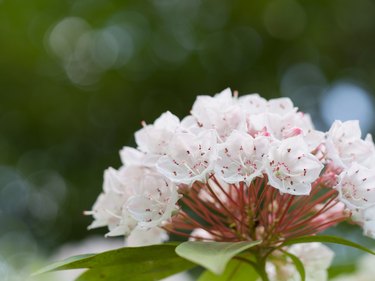
It can be very enjoyable to plant a garden or give floral gifts based on plants that have a deep meaning. For instance, you might wonder about the Kalmia flower meaning, which is also called mountain laurel (Kalmia latifolia, USDA plant hardiness zones 4 to 9). There is also a plant called the bay laurel (Laurus nobilis, USDA zones 7 through 10), which is native to the Mediterranean region and is an aromatic evergreen that holds few similarities to the mountain laurel.
Kalmia Flower History
Video of the Day
The Kalmia is so named because it was discovered by Peter Kalm, a Swedish botanist. Kalm visited North America in 1748, seeking plants that might be useful to the economy in Scandinavia. He ultimately discovered a number of plants and has one genus and 90 species of plants named after him.
Video of the Day
He also wrote a book titled "Travels in North America." This tome encouraged interest in natural history in Sweden and helped Europeans better understand life and culture in North America.
Today, the mountain laurel is still very popular despite its toxicity. In fact, it is the state flower of both Connecticut and Pennsylvania.
Kalmia Flower Meaning
Ever since Kalm's travels, the mountain laurel has been a symbol of hard work and perseverance. It can also be used to mean treachery, since it is extremely aesthetically pleasing but also poisonous. While the plant may not kill a human, it can cause irritation to the skin, eyes and other mucus membranes, and it can even cause nausea and vomiting for some people.
In some cultures, the mountain laurel is associated with ambition. This dates back to the ancient Greeks, who were well-known for using wreaths of laurel to decorate poets, scholars and other great thinkers. Athletes and heroes of war as well as politicians would often wear such a headpiece to indicate their status.
In Greek mythology, Apollo, the god of archery, music, dance and many other things, fell in love with the beautiful Daphne. She did not wish to spend time with the lovestruck deity, and she was turned into a laurel tree as she fled. He took a branch from the tree as a memento of his love. In this story, the laurel symbolizes Daphne's treachery by refusing to love Apollo rather than symbolizing ambition or perseverance.
Mountain Laurel Plant Care Basics
The mountain laurel is native to the eastern United States and is technically a broadleaf evergreen. It grows between 5 and 15 feet high and can spread the same distance in width. It typically blooms in May, producing flowers that are rose to white in color with purple markings.
Mountain laurels prefer to grow in areas with part shade, though they can grow in a wide variety of light conditions. Generally, if they have morning sun with early-afternoon to midafternoon shade, they will grow optimally. They require acidic, well-draining soil. If you are growing these plants at home, it may help to provide mulch to help them retain their moisture.
You should remove spent flower blossoms from your mountain laurel immediately after it blooms to keep the plant healthy. Pruning them lightly after they bloom will also encourage greater growth and a bushier shape. This plant is toxic to both humans and animals, so you should not allow your pets to chew it. Wear gloves when pruning it.